With a tourist trip to Madrid of several days, you cannot miss a excursion to El Escorial.
Surely you already know its impressive monastery It is the main attraction of the beautiful town of San Lorenzo de El Escorial, on the slope of the Sierra de Guadarrama from Madrid, only 53 kilometers from the capital.
El Monastery of El Escorial has been considered as the Eighth Wonder of the World and declared Heritage by Unesco.
You may know that it was built by order of the king Philip II between the years 1563 and 1584, on the one hand, to commemorate the Battle of San Quentin, and in turn, to be used as royal pantheon for the Spanish monarchy.
The enormous building, which extends over an area of more than 35.000 square meters, is located on the slope of the Mount Abantos, and was built on land that was near a small village at that time.
So that you can locate it, that village corresponds to the current town of El Escorial, the first city you access from Madrid, while the town of San Lorenzo de El Escorial It arose later and spread around the monastery.
To see its privileged location at the foot of the Sierra de Guadarrama It is best to do it from the nearby place known as the Felipe II chair.

All the information in detail
- 1 How to get to El Escorial
- 2 Curiosities about the history of the El Escorial monastery
- 3 The best things to see in El Escorial and its monastery
- 3.1 Bourbon Palace in El Escorial monastery
- 3.2 Palace of the Austrias in El Escorial monastery
- 3.3 Museum of Paintings in El Escorial monastery
- 3.4 Pantheon of Kings in El Escorial monastery
- 3.5 Library of the Escorial monastery
- 3.6 Stairs to the Cloister of the El Escorial monastery
- 3.7 Patio de Reyes and Basilica Monastery El Escorial
- 3.8 More information about the Monastery of El Escorial
How to get to El Escorial
Apart from by car, to go to visit the monastery that is near Madrid You can do it on your own by public transportation.
Here you have the information about how to get to El Escorial by train or bus.
You also have the option to sign up for Tour to visit the monastery of El Escorial with the company of a guide in spanish, a visit that will take you all morning and during which you will also pass through the Valley of the Fallen
Curiosities about the history of the El Escorial monastery
Of the enormous dimensions of the Monastery of El Escorial, It will give you an idea to know that after its construction in the 21th century in a record time of only XNUMX years, it became the largest building in all of Europe.
The project was started by John the Baptist of Toledo, who was the architect of the king Philip II , although other architects later intervened, among them, Juan de Herrera, which gave name to herrerian architectural style that characterizes the majestic building.
Indeed, when you arrive before the Monastery of El Escorial, you see that it is a building of imposing monumentality, but with very austere lines, in an intermediate step between the Renaissance style and neoclassical.
The building houses, on the one hand, a Augustinian monastery, but also other different rooms, in some cases, of great historical and artistic value.
Likewise, the so-called Royal Site of San Lorenzo de El Escorial It includes various buildings and royal gardens that are located around the monastery building, which you can also visit, as is the so-called Prince's House.
The main facade of the Monastery of El Escorial It is the one on the west side, and behind them opens the axis of this monumental complex, which is the Courtyard of the Kings, and after crossing it, you will reach the Basilica.
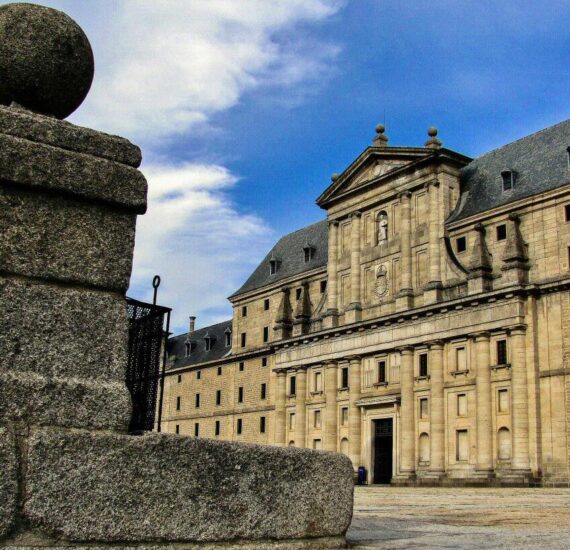
The best things to see in El Escorial and its monastery
The center of your excursion to El Escorial It will be a visit to the monastery, although I can tell you that if you have time, it is worth taking a walk through the streets bordering this great monument.
For you visit to the Escorial Monastery You must enter through the north façade, where the ticket offices are located.
Bourbon Palace in El Escorial monastery
Although you can visit on your own, only if you sign up for the highly recommended guided tours You will have the opportunity to tour, first of all, the rooms that are known as the Bourbon Palace.
This set of rooms shows the characteristic decoration style of the dynasty of French origin, and its numerous tapestries stand out above all.
ORGANIZE your TRIP
- Don't forget your TRAVEL INSURANCE with a 5% discount
- Book the HOTEL for your trip
- RENT a CAR for your trip
- The best TOURS and EXCURSIONS in Spanish
- NO-LINE TICKETS for museums and monuments
- Best FREE TOURS around the world
- Book your TRANSFER from the airport
- eSIM card with INTERNET at the best price
Palace of the Austrias in El Escorial monastery
Then you will visit the so-called Habsburg Palace: House of Philip II, which was once used as a royal residence.
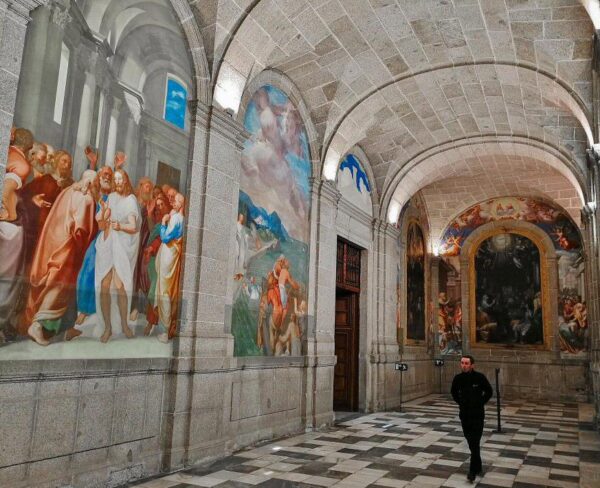
Totally different from the Bourbons, these palatial rooms stand out for the great austerity of their decoration.
It was the royal residence during the stays of Felipe II in El Escorial, and among other rooms you will see the king's bedroom and the spectacular Hall of Battles, from my point of view, one of the most outstanding corners of the entire monastery.
There you can see the enormous paintings that cover the walls on one side of the room in which numerous battles of the time are represented.
Museum of Paintings in El Escorial monastery
You will also see the Chapter Rooms, in whose design the painter Velázquez, which were once used by monks.
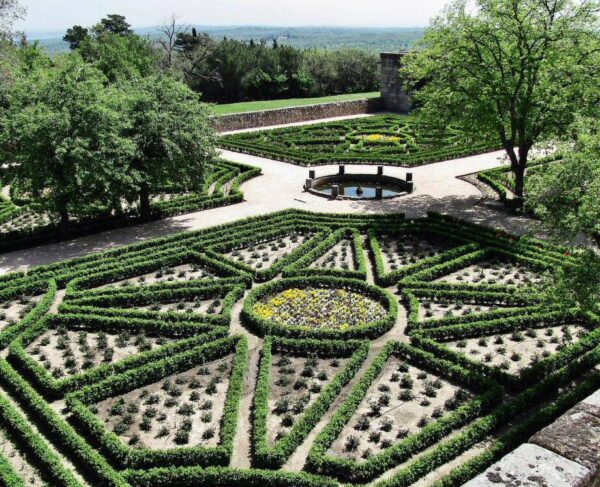
In this succession of rooms they house a museum of paintings, with important works of Velázquez, El Greek y Ribera, among others.
But, without a doubt, the two most important rooms of the Escorial Monastery, are the historical place Pantheon of Kings and Library, corners that more than justify a visit to the interior of the monastery.
Pantheon of Kings in El Escorial monastery
This impressive area of El Escorial Monastery located under the Main Altar of the Basilica, houses the tombs of the Kings of Spain of the dynasties of the Habsburgs and Bourbons.

El Pantheon of Kings of Escorial It is a large, high-rise circular room built in the 17th century baroque style.
Next to said room you can also see the Pantheon of Infants, which was ordered to be built in the 19th century by Queen Elizabeth II.
In this area set up to house the tombs of the numerous relatives of the kings, the tomb stands out with the spectacular recumbent sculpture of don john of austria.
Library of the Escorial monastery
La Library was created by himself king Philip II, who wanted to collect all the books that were published in Spain.
In fact, king Philip II He issued a decree in 1612 by which a copy of each book that was published had to be sent to said library.
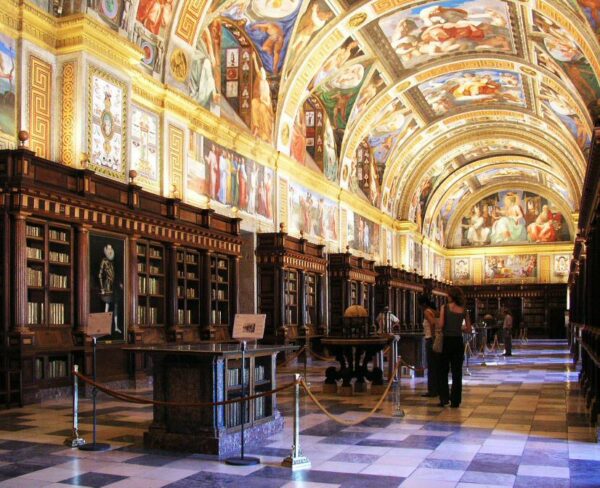
In parallel, to the Library of the Monastery of El Escorial, also known as the Escurialense, Collections of manuscripts and ancient volumes that were being acquired were incorporated.
The result is that the library has come to have up to 40.000 volumes and incunabula of very different origins, such as Latin, Greek, Arabic codices, etc... but especially from the 15th and 16th centuries.
In advance of your trip, and to ensure availability due to capacity limitations, here you can make the online purchase of tickets to the El Escorial monastery, whose price includes a complete Madrid Cultural Guide in pdf
In your visit to the Library of the Monastery of El EscoriaWhat you are going to see is the spectacular main room.
At 59 meters long and 10 meters wide, what will undoubtedly catch your attention the most is its great vault decorated with frescoes painted by Pellegrino Tibaldi, with allegorical themes of Renaissance style.
The sides of this large room are covered by imposing noble wood shelves, such as oak, mahogany and cedar, which were designed by the monastery's own architect, Juan de Herrera.
Don't forget your Travel Insurance
Are you organizing your trip or getaway? Don't leave without take out your travel insurance before, and here we explain why. If you hire it with us, you have a 5% discount

During your walk through the library you can appreciate the thousands of incunabula that are distributed throughout the aforementioned shelves, one of the most precious being the one of the Songs of Santa Maria de Alfonso X the Wise.
Another very prominent element in the room is the spectacular Ptolemaic sphere de Felipe II, from the year 1582, in which you can see a representation of the earth as the center of Universe.
Stairs to the Cloister of the El Escorial monastery
Another highlight during a visit to the monastery is the grand staircase which opens in the main cloister of the monastery, known as Courtyard of the Evangelists.
From the cloister itself you will be struck by the great decoration with frescoes on the ceiling of the staircase.
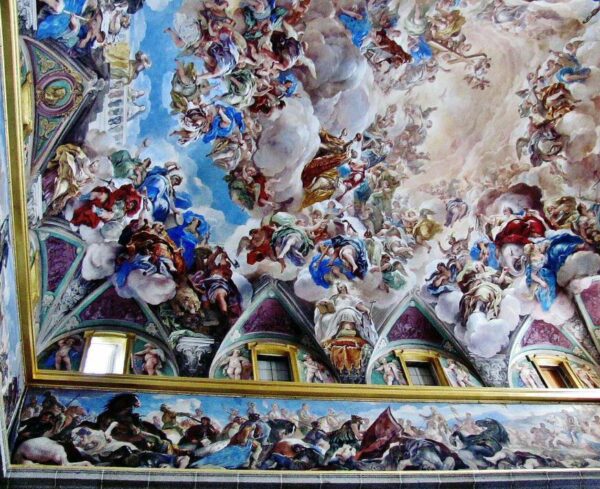
I recommend that you go up to the first landing to appreciate this decoration.
The main staircase of the Main Cloister it was built by Juan Bautista, with the characteristic initial branch that then opens into two branches to reach the second level of the cloister.
On the main staircase, its 52 granite steps, each of them made in a single piece.
The Fresh that decorate the ceiling of this room represent different motifs and were painted at different times.

Thus, along with frescoes of religious themes, such as the glory and life of Jesus Christ, there are other non-religious themes such as Battle of San Quentin or the construction of one's own Monastery of El Escorial.
In this way, together with images of The Virgin y angels, you can also see those of the kings Carlos V y Felipe II, and also to Charles II, who a century after the construction of the staircase commissioned its decoration with new frescoes.
Among the artists who participated in the creation of the frescoes at different times, the following stand out: Tibaldi y Lucas Jordan (Luca Giordano).
Patio de Reyes and Basilica Monastery El Escorial
El Courtyard of Kings It is the main open space that you find in the large complex of the El Escorial Monastery.
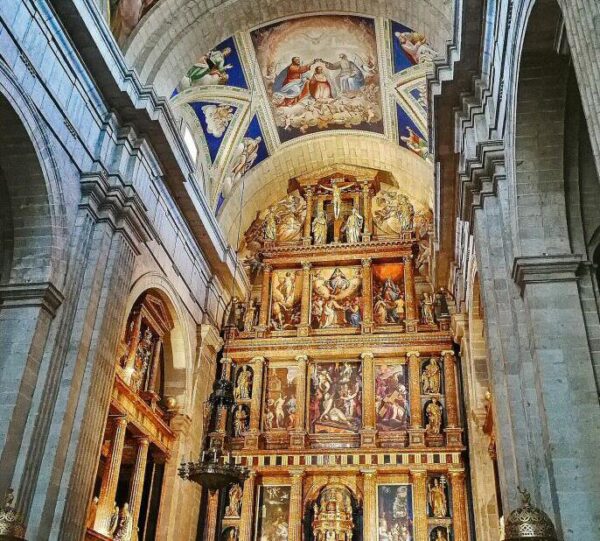
During your visit you will leave through the door that opens on the north façade and that takes you to this large patio where the Basilica of El Escorial.
Inside, its very thick columns and the large 95-meter-high dome will catch your attention.
Also highlights the great altarpiece High altar designed by himself Juan de Herrera.
Book your hotel, 15% discount, free cancellation
When planning your trip, we advise you to, well in advance, Book your hotel now on booking.com where you can find discounts from 15% and you will have a possible cancellation for free
With great austerity in its decoration, almost non-existent, this basilica will give you a great feeling of robustness.
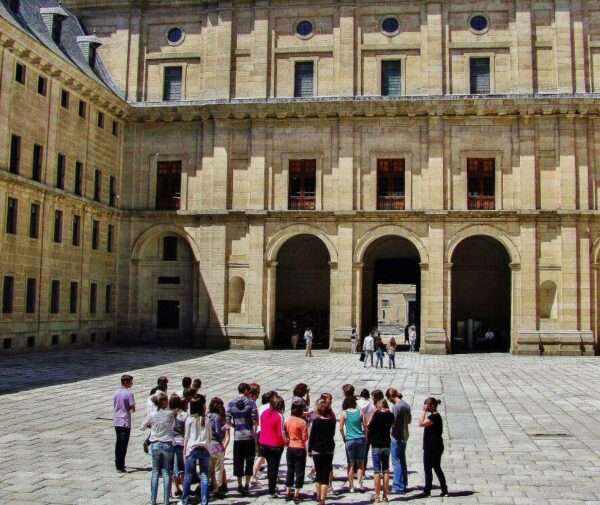
In sum, a essential visit, Together with visit of Toledo, if you have a minimum of time on your trip to Madrid.
More information about the Monastery of El Escorial
- Panoramic views of the Monastery of El Escorial from the Chair of Felipe II
- Panoramic views of the Monastery of El Escorial from Mount Abantos
- Pantheon of Kings in the Monastery of El Escorial
- How to visit the Monastery of El Escorial: schedules, ticket prices



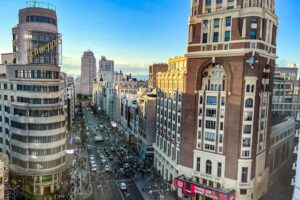
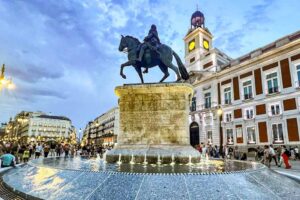
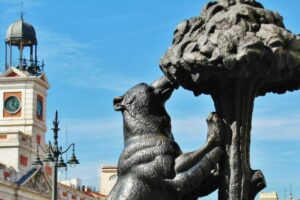











congratulations Jose Luis.
The information you give is very interesting.
I want to visit the Monastery on 24/10/2015.
I am a member of a Choir and while we are giving a concert, we want to visit it.
I hope to get in touch on the phones. What do you give because we are a group of 20/30 people and we can be specific.
alixia.
You had the opportunity to experience this fantastic place and you will return with certainty!!
I really liked the monastery of El Escorial, we have very beautiful buildings and we don't value it at almost 600 years old. I hardly know Spain at 65 years old. I have been a worker and I haven't seen anything. Well, I have taken my children and grandchildren out.
Thanks for your comment, Miguel.